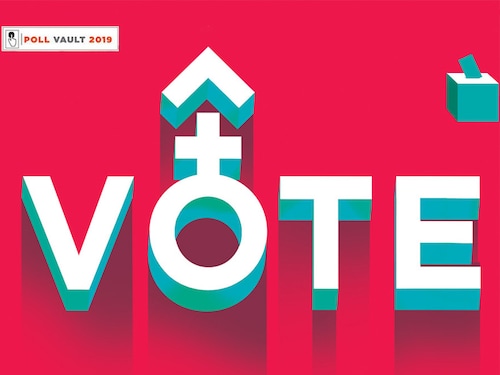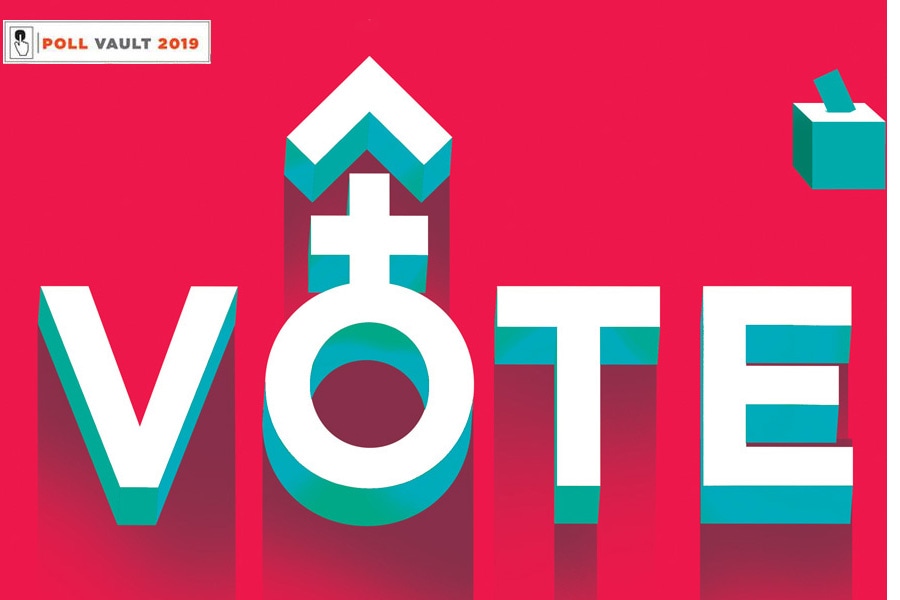The shifting gender equations of India's polls
The numbers that explain the increase in women voters in assembly and general elections


 Illustration: Sameer Pawar [br]Over the years, one of the things that hasn’t changed about democracy in India is the number of women Members of Parliament (MPs) in the Lok Sabha. In 1962, 66 women stood for elections of which 31 won, representing 6.3 percent of the total House (494 members). In 2014, the number of women candidates for Lok Sabha polls had increased to 668, 10 times the number in 1962, with 62 winning the elections. They represented around 11.4 percent of the total number of MPs (543). In over five-and-a-half decades, the number of women in the Lok Sabha has just doubled.
Illustration: Sameer Pawar [br]Over the years, one of the things that hasn’t changed about democracy in India is the number of women Members of Parliament (MPs) in the Lok Sabha. In 1962, 66 women stood for elections of which 31 won, representing 6.3 percent of the total House (494 members). In 2014, the number of women candidates for Lok Sabha polls had increased to 668, 10 times the number in 1962, with 62 winning the elections. They represented around 11.4 percent of the total number of MPs (543). In over five-and-a-half decades, the number of women in the Lok Sabha has just doubled.
How are things when it comes to women voters? Prannoy Roy and Dorab R Sopariwala study this issue in detail in their book, The Verdict—Decoding India’s Elections. The voter turnout of women in the 1962 elections was 46.7 percent. By 2014, it increased to 65.5 percent. But there is more to this.
According to the graph ‘Turnout of women in Lok Sabha elections’, from 1977 to 2009, the women voter turnout remained between 50 percent and 60 percent. It reached a peak of 58.6 percent in 1984 and was at 55.8 percent in 2009. In 2014, the turnout among women voters was 65.5 percent of the nearly 39.7 crore women who could have voted, around 26.02 crore did.
Voter turnout among women has always been lower than the overall turnout. But in 2014, this difference was at its lowest level: Overall voter turnout was 66.4 percent, while women voter turnout was 65.5 percent. In 2014, other than a greater proportion of women voting, there was a huge increase in the total number of women voting as well. In 2009, around 19.1 crore women had voted, while in 2014 this number rose by an unprecedented 7 crore (almost).
In the graph ‘Increase in number of women voters’, between 2009 and 2014, the number of women voters rose by a massive 6.92 crore. A possible explanation for this lies in India’s demographic dividend: The number of women above the age of 18 rose by 5.48 crore. It would seem a bulk of these women, and others, are voting.
One way of testing this theory is to look at a few large assembly elections between 2014 and 2019. In Bihar, the state with the lowest per capita income, in 2010, women voter turnout was 54.49 percent in 2015 it was 60.54 percent. In both years, the turnout of women was more than the overall voter turnout of 52.73 percent and 56.91 percent, respectively. A possible explanation for this lies in the fact that the number of women eligible to vote in Bihar went up by 48.3 lakh.
The 2017 assembly election in Uttar Pradesh shows a similar trend. The turnout of women was 63.31 percent in 2017, against 60.28 percent in 2012. The overall turnout had stood at 61.24 percent and 59.52 percent, respectively. This could possibly be because many men in these states migrate to other states for work. It may not be possible for them to come back and cast their vote.
It would be interesting to see what the women voter turnout will be in this election, which has nearly 43.13 crore women voters. In the 2014 Lok Sabha elections, the women’s turnout rate was 65.5 percent against the overall rate of 66.4 percent the turnout rate among men was 67 percent. A look at the assembly elections since 2014 shows a greater proportion of women voting than men. It’s possible something similar might happen in this Lok Sabha elections.
So how will this impact political parties? Roy and Sopariwala write: “The BJP has had a higher support base amongst men than women. For example, in the 2014 Lok Sabha elections, the lead of the NDA over the UPA amongst men in India was 19 percent while its lead amongst women voters was 9 percent (based on our opinion polls and exit polls).”
This male-centric support is even more pronounced in states in central, north and western India. The difference in support can be made out from the following calculation. If only women had voted in 2014, the NDA would have ended up with 265 seats, 71 less than what it won. If only men had voted, the NDA would have won 376 seats. The Narendra Modi government has tried to tackle this through programmes like Pradhan Mantri Ujjwala Yojana to some extent.
To conclude, while women are having a greater say in democracy, a bigger problem still remains, Roy and Sopariwala point out. In 2019, the total number of women eligible to vote is 43.13 crore, while the figure for men is 46.47 crore, a ratio of 92.7 percent. This means, for every 1,000 men eligible to vote there are 927 women. However, based on the 2011 census, for every 1,000 men aged above 18, there should be 972 women this means 45 women voters missing for every 1,000 men voters.
As Roy and Sopariwala write: “The 4.5 percent of missing women translates into as many as 21 million women who are denied their constitutional right to vote simply because their names are not registered in voter lists around the country.”
(Vivek Kaul is an economist and the author of the Easy Money trilogy)
First Published: Apr 24, 2019, 12:32
Subscribe Now